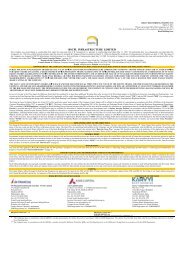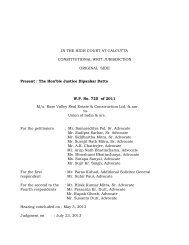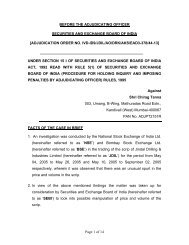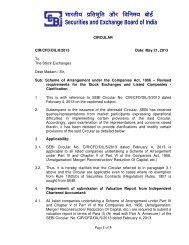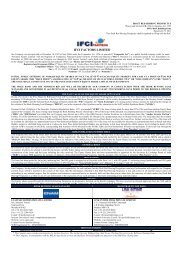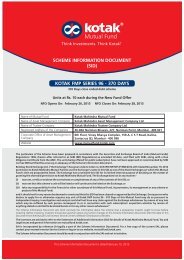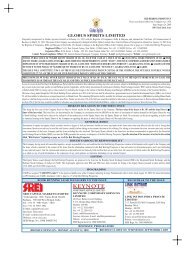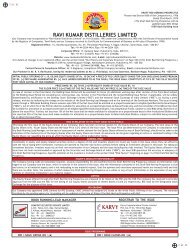KAMDHENU ISPAT LIMITED - Securities and Exchange Board of India
KAMDHENU ISPAT LIMITED - Securities and Exchange Board of India
KAMDHENU ISPAT LIMITED - Securities and Exchange Board of India
You also want an ePaper? Increase the reach of your titles
YUMPU automatically turns print PDFs into web optimized ePapers that Google loves.
A. Construction<br />
As a part <strong>of</strong> the shelter component <strong>of</strong> the national agenda, the government has estimated a shortage <strong>of</strong> 13 lakh<br />
houses in rural <strong>and</strong> 7 lakh in the urban areas in <strong>India</strong>.<br />
Construction activity is also on an upswing due to a surge in retail development with shopping malls <strong>and</strong> multiplexes.<br />
This is due to rising disposable incomes among the middle class <strong>India</strong>ns <strong>and</strong> availability <strong>of</strong> cheap finance. The<br />
construction activities are also getting modernized <strong>and</strong> there is a steady departure from the traditional brick <strong>and</strong><br />
mortar format to steel intensive <strong>and</strong> composite structures. In <strong>India</strong>, the future for steel intensive construction is<br />
promising. With steep rise in the l<strong>and</strong> prices <strong>and</strong> the high population density, cities are growing vertically <strong>and</strong> new<br />
generation steel multi-stories seem to be the future in congested metros. Composite flyovers <strong>and</strong> bridges at crowded<br />
metros <strong>and</strong> busy highways can be cost-effective solutions – <strong>and</strong> the trend has already begun.<br />
Steel-intensive/steel-concrete composite bridges became the preferred options since the mid eighties after the<br />
publication <strong>of</strong> BS 5400 codes. In UK today, 35% <strong>of</strong> total bridges built are composite constructions. Even minor items<br />
like steel rod reinforced dividers, crash barriers <strong>and</strong> wire meshes to prevent cattle <strong>and</strong> humans from venturing onto<br />
high-speed modern highways are now used in a big way. Steel intensive multi-storied car parks can provide quick<br />
solutions to congested metros. Cities <strong>of</strong> Mumbai, Delhi <strong>and</strong> Bangalore are building rail based mass rapid transit<br />
systems (underground or on elevated steel reinforced concrete pillars) to take care <strong>of</strong> the urban traffic problem.<br />
The experienced <strong>and</strong> developed western economies are taking maximum advantage <strong>of</strong> increased usage <strong>of</strong> steel in<br />
construction. For example in the UK, more than 90% <strong>of</strong> single storey buildings are steel framed <strong>and</strong> about half <strong>of</strong><br />
these are portal frames. In 1991-92, steelwork construction in the UK had a market share <strong>of</strong> 59%, in Sweden <strong>of</strong> 50%<br />
<strong>and</strong> in Netherl<strong>and</strong>s 26% in commercial construction. In industrial buildings, the market share <strong>of</strong> steelwork construction<br />
is reported to be between 77-92% in the UK, Sweden, Netherl<strong>and</strong>s, Spain, Belgium <strong>and</strong> France. The situation in<br />
USA <strong>and</strong> Japan is almost similar. [Source: www.steelworld.com]<br />
Trends in <strong>India</strong> generally mirror global trends <strong>and</strong> the use <strong>of</strong> steel in construction is no exception. This phenomenon<br />
is set to grow at an exponential rate in coming years as <strong>India</strong> witnesses its own construction boom. Even today, glass<br />
<strong>and</strong> steel buildings in industrial <strong>and</strong> IT hubs <strong>of</strong> Gurgaon, Bangalore, Mumbai <strong>and</strong> Hyderabad are visible.<br />
B. Infrastructure<br />
There has been a tremendous need for total infrastructure revolution in the post liberalization era. The government’s<br />
focus on the golden quadrilateral road project, the proposed modernization <strong>and</strong> expansion <strong>of</strong> the country’s ports <strong>and</strong><br />
the planned expansion <strong>of</strong> the railway network – are all potential dem<strong>and</strong> generators for the industry. Like most <strong>of</strong> the<br />
developed countries with a solid infrastructure base, we need to adopt the steel intensive or steel-concrete composite<br />
construction route. The National Highway Development Project has increased allocation from Rs. 65.14 billion to<br />
Rs. 93.20 billion <strong>and</strong> an additional Rs. 55 billion for the National Urban Renewal Mission.<br />
The fillip given to modernizing <strong>India</strong>’s infrastructure will lead to an upsurge in dem<strong>and</strong> <strong>of</strong> long products for use in<br />
roads, bridges <strong>and</strong> highways <strong>and</strong> related steel requirements. The use <strong>of</strong> MRTS to solve urban traffic congestion<br />
problems will also require huge amounts <strong>of</strong> steel, especially mild steel products.<br />
CRIS INFAC has also forecast the industrial investment to increase by 70% over the next five years compared with<br />
the past five years. The average annual investment is expected to increase from Rs.380bn over the past five years<br />
(98-99 to 03-04) to Rs.630bn over the next five years (04- 05 to 08-09). These massive investments are expected to<br />
result in construction dem<strong>and</strong> <strong>of</strong> Rs.100bn from industrial projects.<br />
Unlike flat products, long products do not mirror the economic conditions <strong>of</strong> a country. They are fairly independent <strong>of</strong><br />
whether the economy is in recession or is in a boom phase. Growth <strong>of</strong> long products is driven by certain policy<br />
decisions <strong>and</strong> the progression <strong>of</strong> a nation’s development.<br />
C. Dem<strong>and</strong> Generators<br />
Global Factors<br />
· Global steel dem<strong>and</strong> is rising on the back <strong>of</strong> accelerated infrastructure activity in China, CIS <strong>and</strong> <strong>India</strong>, housing<br />
boom in the USA, <strong>and</strong> the resurgence <strong>of</strong> white goods in Europe. In the recent recessionary phase, the industry<br />
has consolidated in terms <strong>of</strong> ownership <strong>and</strong> moth balling <strong>of</strong> inefficient capacities. Therefore, steel prices are<br />
expected to firm up further.<br />
· For the first time in last 20 years, there is worldwide dem<strong>and</strong> growth for steel.<br />
· In US, dem<strong>and</strong> is led by the booming housing industry. Additionally the auto industry too is showing signs <strong>of</strong><br />
recovery.<br />
· In Europe, there is dem<strong>and</strong> from a buoyant housing <strong>and</strong> white goods industry.<br />
38



